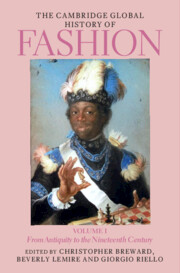Book contents
- The Cambridge Global History of Fashion
- The Cambridge Global History of Fashion
- The Cambridge Global History of Fashion
- Copyright page
- Contents for Volume I
- Figures for Volume I
- Maps for Volume I
- Table for Volume I
- Contributors for Volume I
- Preface
- 1 Global History in the History of Fashion
- Part I Multiple Origins of Fashion
- Part II Early Modern Global Entanglements
- Part III Many Worlds of Fashion
- 13 ‘Black Cloth’
- 14 Fashion and Moral Concern in Early Modern Japan
- 15 Textiles and Fashion in Southeast Asia
- 16 Fashion in Ming and Qing China
- 17 Everyday Fashion in the Ottoman Empire,C. 1600–1800
- 18 Imperialism and Fashion: South Asia, c. 1500–1800
- 19 Fashion Systems in the Indian Ocean World, from Ancient Times to c. 1850
- 20 Fashion and First Peoples in European Settler Societies, c. 1700–1850
- Index
- References
15 - Textiles and Fashion in Southeast Asia
from Part III - Many Worlds of Fashion
Published online by Cambridge University Press: 04 August 2023
- The Cambridge Global History of Fashion
- The Cambridge Global History of Fashion
- The Cambridge Global History of Fashion
- Copyright page
- Contents for Volume I
- Figures for Volume I
- Maps for Volume I
- Table for Volume I
- Contributors for Volume I
- Preface
- 1 Global History in the History of Fashion
- Part I Multiple Origins of Fashion
- Part II Early Modern Global Entanglements
- Part III Many Worlds of Fashion
- 13 ‘Black Cloth’
- 14 Fashion and Moral Concern in Early Modern Japan
- 15 Textiles and Fashion in Southeast Asia
- 16 Fashion in Ming and Qing China
- 17 Everyday Fashion in the Ottoman Empire,C. 1600–1800
- 18 Imperialism and Fashion: South Asia, c. 1500–1800
- 19 Fashion Systems in the Indian Ocean World, from Ancient Times to c. 1850
- 20 Fashion and First Peoples in European Settler Societies, c. 1700–1850
- Index
- References
Summary
Southeast Asia has an exceptionally rich textile history, and weaving has developed into a high art form in the wider region. The imagination and creativity that one finds reflected in the making of cloth, its detailed patterning and overall design, is equal in aesthetic quality to artistic forms that usually are associated with the more conventionally recognized visual arts of a culture, such as painting and sculpture. Cloth was and is first of all used to dress the human body. For this reason, it is also evident that textile production and design connect to a long history of change: what one may call a history of fashion. But textiles also have an unusually deep cultural significance in the region. They play an essential part in many ceremonies and rituals, either as ostentatious displays or as part of offerings, and they often are essential in gift exchanges that establish and emphasize social relationships. Southeast Asia as a region has been on the crossroad of exchanges between West and East for millennia, with direct connections between South and East Asia resulting in a particularly fruitful mixture of Indigenous and outside social and religious ideas.
- Type
- Chapter
- Information
- The Cambridge Global History of FashionFrom Antiquity to the Nineteenth Century, pp. 500 - 532Publisher: Cambridge University PressPrint publication year: 2023

